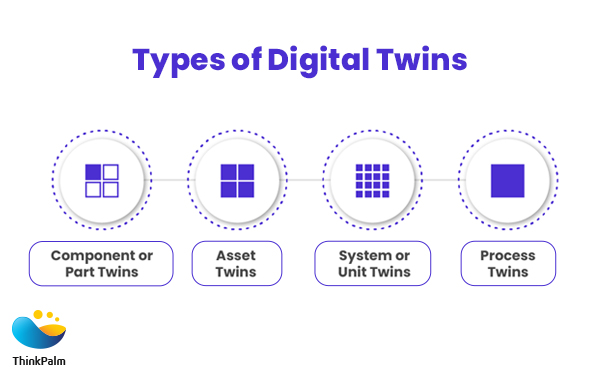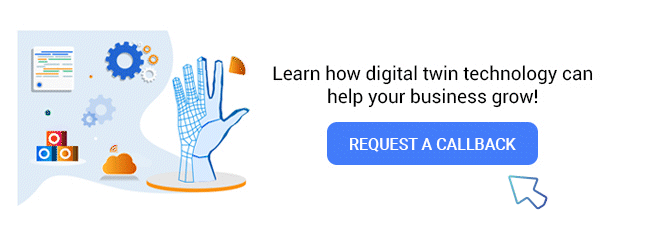A digital twin is more like a virtual “you.”
You can think about it as having a digital copy of yourself, a replica in a digital world—your home, workplace, city—all perfectly mirrored.
What if this digital version of you—your digital twin—couldn’t feel pain, hurt, or be embarrassed? Isn’t that mind-blowing?
Thus, this could mean making decisions with much more confidence.
On top of all, this certainty is highly valuable in business, and emerging digital twin technology can help you make it happen!
In this article, let us delve deeper into more details about how digital twin technology works, its incredible benefits, and how it’s transforming industries. Stay tuned!
A digital twin is a virtual version of an actual system or real-world object. Moreover, it’s a digital replica that mirrors the physical entity’s characteristics, behavior, and state.
Moreover, this incredible technology allows for real-time monitoring, analysis, and simulation, helping improve efficiency.
Further, using digital twins, you can monitor and identify issues in real-time, reduce downtime, and make informed decisions regarding strategic, operational, and resource allocation enhancements.
In addition, digital twins can digitally recreate numerous real-world items, from individual factory equipment to structures like wind turbines or even entire cities.
Also, digital twins allow you to track how well an asset works, spot possible issues, and make smarter decisions about maintenance and its overall lifespan.
In other words, whether it’s a car, a building, or even a city, the digital twins offer an advanced way to understand and optimize real-world objects.
Digital twins offer numerous advantages to users. We’ll go over some of the popular points.
Digital twins offer up-to-the-minute data and valuable insights, enabling you to enhance the efficiency of your equipment, plants, or facilities. Furthermore, by addressing issues promptly, these digital replicas ensure optimal performance and minimize downtime.
Imagine your factory or building with lots of equipment. Digital twins give you a complete view of everything through smart sensors that monitor each piece. Moreover, if there’s a problem, you get an alert immediately, letting you fix things before they worsen. Hence, this proactive approach allows you to address problems at the first sign of trouble instead of waiting for equipment to fail.
Digital twins, being virtual, can be monitored and controlled from afar. This means you don’t need as many people to physically check on potentially risky industrial equipment, enhancing safety.
Making digital copies of products and places before building them speeds up production. Moreover, testing different scenarios helps you see how your products or facility handles failures so you can fix them before starting the production process.
Many industries are using digital twins to create virtual versions of their physical systems. Some of them include the following.
Construction teams use digital twins for planning projects in real time. Also, architects are using digital twins with 3D models for better project planning. Similarly, with the help of digital twins, commercial building managers track real-time and historical data to enhance occupant comfort.
Digital twins play a crucial role in the entire manufacturing lifecycle, from planning and designing to maintaining current facilities. In addition, a digital twin prototype allows you to monitor machinery and analyze performance data, providing insights into the overall operation of your plant or specific components.
In the energy sector, digital twins are extensively employed for strategic project planning and optimizing the performance of assets like offshore installations, refining facilities, wind farms, and solar projects.
The automotive industry leverages digital twins to create digital vehicle models, providing insights into physical behavior, software, and mechanical and electrical models. On top of all, predictive maintenance is valuable, as digital twins can alert service centers or users to issues with component performance.
Digital twins find applications in healthcare, creating virtual replicas of entire hospitals, healthcare facilities, labs, and human bodies. Moreover, they are used to model organs and run simulations to understand how patients respond to specific treatments.
Digital twins come in different types, and they can work together in one system. Some focus on specific parts of an object, but all are important for creating a virtual version. The main types include:
Component twins, also known as parts twins, are digital representations of individual system components. Moreover, these are necessary components for an asset’s operation, like the motor in a wind turbine.
Assets are defined as two or more components that function together as a part of a more comprehensive system in the context of digital twins. In addition, asset twins provide performance data that can be analyzed to help you make decisions by virtually simulating how the components interact with one another.
System twins, also known as unit twins, are an even more abstract concept than asset twins. In addition, a system twin demonstrates how various components function as a unit within a larger system. Also, system twin technology gives you the visibility you need to make decisions about efficiency gains or performance improvements.
With process twins, you can see an object’s entire digital environment and gain an understanding of how its different parts, resources, and units function as a whole. A digital process twin, for instance, can digitally replicate the way your whole manufacturing plant functions, bringing all of its parts together.
A digital twin creates a virtual replica of a physical asset, encompassing its functions, attributes, and actions within a digital space.
Moreover, this real-time representation is generated through intelligent sensors gathering data from the actual product.
On top of all, this digital counterpart can be employed throughout the asset’s entire lifespan, spanning from initial testing to real-world operations and eventual decommissioning.
Various technologies contribute to the development of digital twins, and these include the following.
IoT is a network connecting devices for communication, including interactions with the cloud and between devices. Moreover, affordable computer chips and high-bandwidth telecommunication have enabled billions of devices to connect to the Internet. Digital twins use IoT sensor data to transfer real-world information to their digital counterparts. Then, this data is updated in real-time on a software platform or dashboard.
Artificial Intelligence (AI) is the field focused on solving cognitive challenges, including learning and pattern recognition. On the other hand, Machine Learning (ML), a subset of AI, develops algorithms for tasks without explicit instructions. In digital twins, AI and ML seamlessly process sensor data, pinpointing patterns to offer valuable insights. As a result, this aids in optimizing performance, streamlining maintenance, managing emissions, and enhancing overall efficiencies.
Simulations and digital twins both use virtual models, but they have some differences. Also, simulations are mainly for design and testing changes, while digital twins are more complex and let you interact with and update things on a bigger scale in real time.
Think of a car simulation. It’s like a video game where a new driver can practice and learn about the car without it being a real car. Now, a digital twin of the car is connected to the actual car, knowing everything about it—like how it’s performing, what parts were replaced before, issues seen by sensors, past services, and more.
What are the three elements of a digital twin?
The digital twin concept involves a physical product, its digital counterpart, and the connections between them.
What is digital twin technology in IoT?
In simpler terms, on an IoT platform, a digital twin is like a digital clone of a real thing—be it a machine, vehicle, or device. Moreover, it mirrors all the info about the physical object, from how it works to its current state and even its journey over time.
What is the major difference between a digital twin and a virtual twin?
A digital twin is like a super-detailed virtual copy of something real, while a virtual twin is a broader digital version without all the fine details. Simply put, a digital twin zooms in on one thing, and virtual twins give you the big picture of the whole environment.
What is digital twin in business?
A digital twin in business is like a digital version of something real—be it an object or a system. Moreover, it covers its entire life journey, gets real-time updates, and uses advanced tech like simulation, machine learning, and reasoning to assist in making informed decisions.
Why and how are digital twins useful?
Digital twins are like smart clones that help us understand, improve, and predict how real things work in business. So, this technology lets companies test and perfect products virtually, creating a digital copy of the production process to catch and fix issues before anything hits the real world.
A major shift is happening in how things work. Therefore, industries with many assets are undergoing a digital transformation, blending physical and digital views of assets, equipment, and processes. Here, digital twins are playing a crucial role in this change.
Hence, the future of digital twins looks promising because they keep learning and gaining more skills. Moreover, this continuous learning helps them provide insights to improve products and make processes more efficient.
So, do you want to know more about leveraging this change in your industry? Connect with our IoT Services experts at Thinkpalm right away!